Coring Locations
Gulf of Mexico Consortium Study Locations

Overview
GERG piston coring consortia between 1985 and 1998 encompass the mid- and upper slope of the northern Gulf rim as well as deep-water regions beyond the Sigsbee Escarpment and in Alaminos Canyon and Keathley Canyon.
Locations
Download PDF map of all locations.
Alaminos Canyon
GERG's 1988 Alaminos Canyon consortium collected 170 cores throughout the Alaminos Canyon protraction area. Core locations were focused along the edge of the deep-water salt sheet, resulting in the detection of oil seepage in association with large structural features. The results extended the incidence of hydrocarbon seeps into greater water depths and contributed to the increased prospectivity of this region.
Deliverables for this study include PDF images of core logs (core locations and descriptions) and data volumes with the results of the following analyses: total scanning fluorescence, C15+ gas chromatography, and C1-C4 hydrocarbons (headspace).
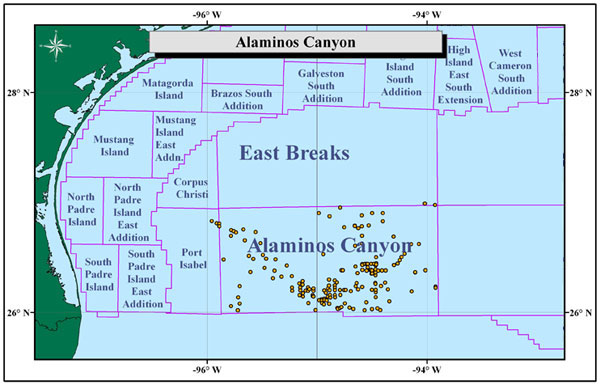
Atwater/Lund/Walker Ridge (Central Gulf)
GERG's 1990 Atwater / Lund / Walker Ridge Consortium encompasses data from 231 cores in deeper areas of the Gulf slope and along the Sigsbee Escarpment in the Walker Ridge area, a geologic transition zone. The cores extend into the extreme southeast corner of Green Canyon, eastward across Atwater Valley to very deep water in the Lund area far out in front of the escarpment. A linear placement of cores in the Atwater Valley protraction area reflects available seismic profiles at that time. Despite the limited geophysical data available in 1990 for locating seeps, this study remains extremely valuable because of the large number of cores involved.
Deliverables for this study include PDF images of core logs (core locations and descriptions) and data volumes with the results of the following analyses: total scanning fluorescence, C15+ gas chromatography, and C1-C4 hydrocarbons (headspace).
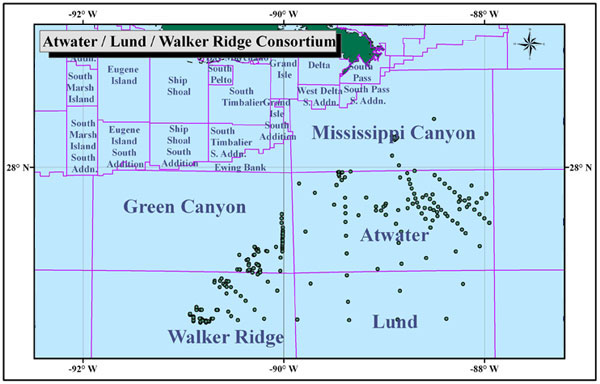
Central and Eastern Gulf Biomarker and Isotope Study (CEGBIS)
The best seep samples from the eastern Gulf of Mexico (DeSoto Canyon, Lloyd Ridge, The Elbow) were extracted in 2000 for the Central and Eastern Gulf Biomarker and Isotope Study (CEGBIS). A total of 76 samples were chosen for state-of-the-art quantitative biomarker analyses (done by Baseline on large sediment samples) and carbon isotope analyses on saturate and aromatic hydrocarbon fractions. The biomarker data are of high quality and are clear in terms of constraining risk of resource value.
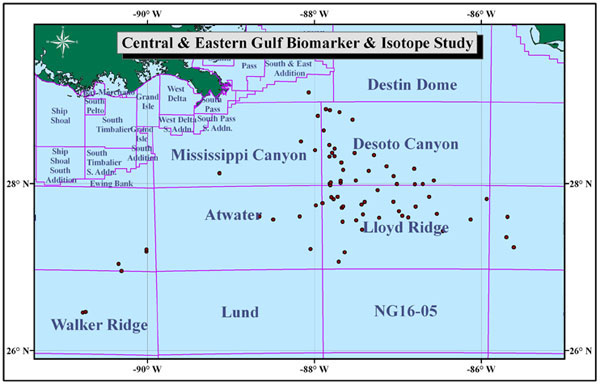
Central Gulf Consortium II
The central Gulf region has been the focus of several GERG piston coring consortium studies. Although the results have revealed thermogenic hydrocarbons widely distributed in the near-surface sediments, prolific hydrocarbon seeps have been encountered at only a few locations. This is in contrast to deepwater protraction areas to the west (e.g., Garden Banks), where hydrocarbon seeps are more common.
The Central Gulf Consortium II (1996-1997) in-filled regional coverage with 224 cores over deep-water areas of Mississippi Canyon, Atwater Valley, Green Canyon and Walker Ridge. The results identified seeps at new locations in Mississippi Canyon and in southern Green Canyon. Biomarker analysis of the seep hydrocarbons suggest a wider regional extent of better-quality oils than had been previously assumed.
Deliverables for this study include PDF images of core logs (core locations and descriptions), data volumes with the results of the following analyses: total scanning fluorescence, C15+ gas chromatography, C1-C4 hydrocarbons (headspace), and biomarker, and a final, interpretive report.
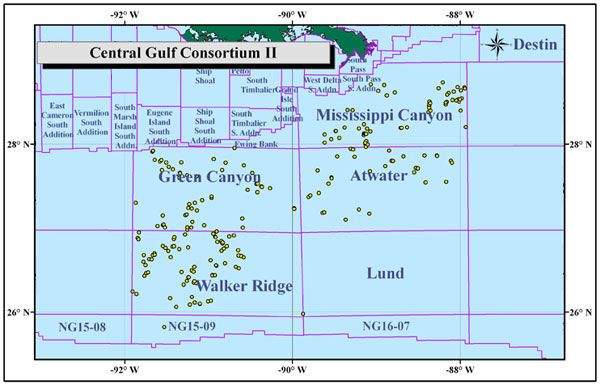
Central Slope Seep Study
The Central Slope Seep Study (1996-1997) sought to identify seafloor seeps across the mid- to lower slope in the Atwater Valley and Walker Ridge protraction areas where both Jurassic and Cretaceous source rocks are thought to be generative. State-of-the-art geophysical techniques were used to site 161 cores in areas that had not been extensively cored in previous studies. The data were used to test the hypothesis that Tithonian source rocks have given rise to oil north of the escarpment, whereas Oxfordian source rocks have given rise to oils in front of the salt sheet.
Deliverables for this study include PDF images of core logs (core locations and descriptions), data volumes with the results of the following analyses: total scanning fluorescence, C15+ gas chromatography, C1-C4 hydrocarbons (headspace), and biomarker, and a final, interpretive report.
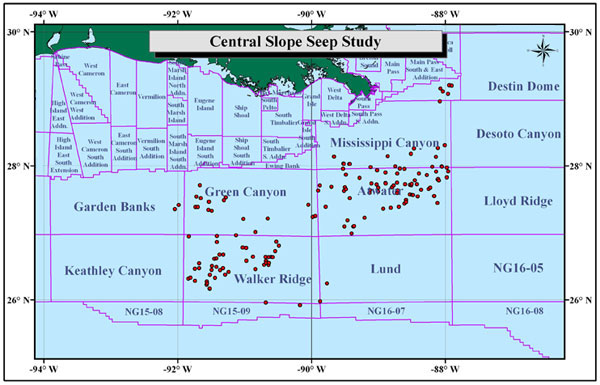
Deep Gulf Calibration Study
The Deep Gulf Calibration Study (1993) is one of the most important coring studies carried out in the Gulf of Mexico. Previous studies had been designed largely on a regional reconnaissance scale to identify sites of hydrocarbon seepage. This study focused 121 cores over known discoveries such as Mars, Ursa, Mickey, Ram-Powell, Hercules/Lobster, and other locations in Ewing Bank and Green Canyon. The results show differences in the intensity and nature of hydrocarbon seepage over stratigraphic and structural traps, and illustrate how most of the major oil discoveries are associated with levels of seepage that relate to the subsurface geology.
Deliverables for this study include PDF images of core logs (core locations and descriptions) and data volumes with the results of the following analyses: total scanning fluorescence, C15+ gas chromatography, and C1-C4 hydrocarbons (headspace).
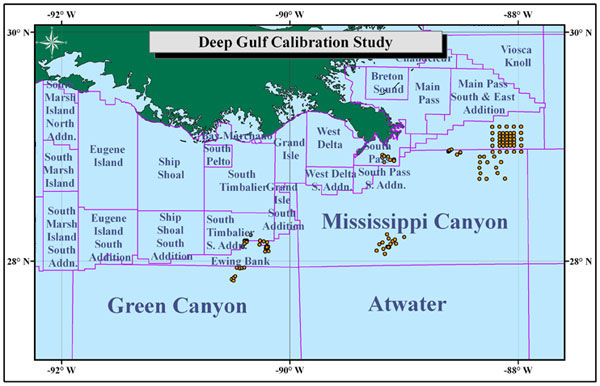
Deepwater Gulf of Mexico Seep Study Phases I and II
With the increasing number of seeps sampled, questions arose regarding the nature and thermal maturity of the hydrocarbon source rocks. In 1989 and 1990, the Deep Gulf Seep Study analyzed biomarker distributions and other geochemical properties in 47 piston cores collected in earlier studies, which exhibited varying levels of thermogenic hydrocarbons.
The results confirmed that seep hydrocarbons over a wide portion of the central and western deep-water Gulf originate from marl to carbonate source rocks. The limits on data interpretation introduced by interference from non-petroleum biomarker compounds that occur naturally in the seafloor sediments were also noted.
Deliverables for this study include PDF images of data volumes with the results of bulk parameter and biomarker analyses.
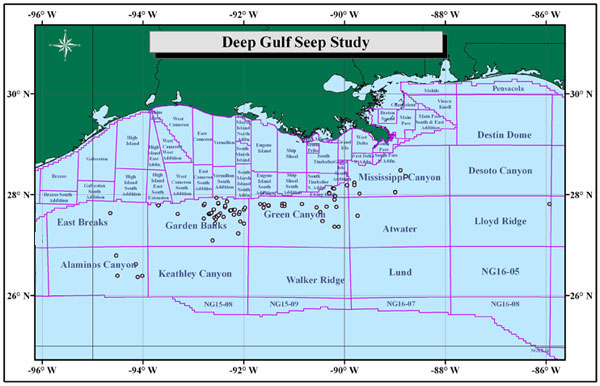
DeSoto Canyon/Lloyd Ridge (Florida Escarpment)
This is the only consortium study that collected cores in the Desoto Canyon, Lloyd and Elbow protraction areas (187 total). Numerous geochemical anomalies suggested a hydrocarbon system south of the Florida Escarpment.
Deliverables for this 1988 study include PDF images of core logs (core locations and descriptions) and data volumes with the results of the following analyses: total scanning fluorescence, C15+ gas chromatography, and C1-C4 hydrocarbons (headspace).
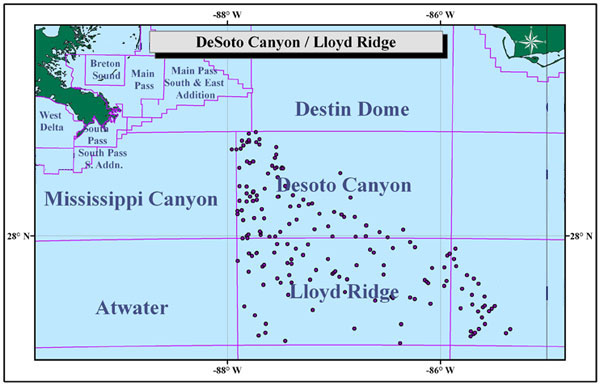
Green Canyon/Mississippi Canyon
Relying on geophysical data available in 1987 to site 229 cores, this study identified geochemical anomalies over a broad region of central Green Canyon, as well as hydrocarbon seeps at specific locations in both Atwater and Green Canyon protraction areas. The findings established the widespread occurrence of hydrocarbon seeps along the upper slope.
Deliverables for this study include PDF images of core logs (core locations and descriptions) and data volumes with the results of the following analyses: total scanning fluorescence, C15+ gas chromatography, and C1-C4 hydrocarbons (headspace).
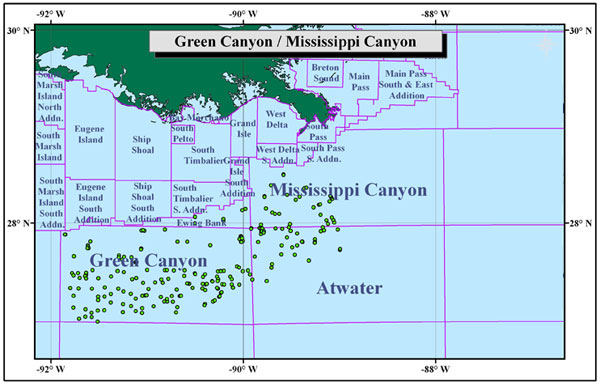
Gulf Sub Salt Seep Study Phases I and II
The Gulf Sub-salt Seep Study (1994), Phases I and II encompassed 97 cores on the outer Gulf of Mexico shelf, defining the boundaries of that sub-salt play. Previous coring along the shelf-edge had not revealed major seeps because seepage had not been associated with lateral petroleum migration along horizontal salt sheets. These surveys identified oil seeps around salt sheets associated with sub-salt discoveries such as Mahogany (Ship Shoal 349), primarily through the use of detailed 3-D seismic to site many of the core locations.
Deliverables for this study include PDF images of core logs (core locations and descriptions) and data volumes with the results of the following analyses: total scanning fluorescence, C15+ gas chromatography, C1-C4 hydrocarbons (headspace), and biomarker.
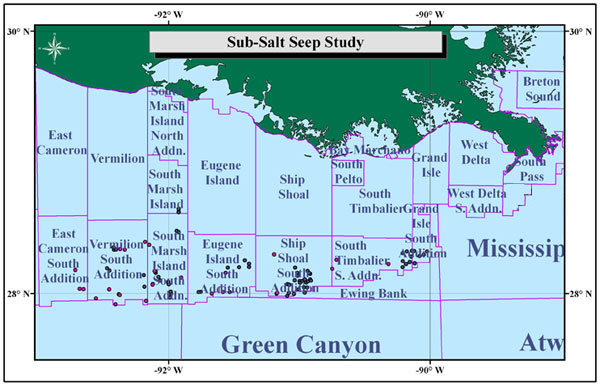
Keathley Canyon/Walker Ridge
The thermal history of petroleum source rocks in the Keathley Canyon-Walker Ridge area is thought to be strongly impacted by extensive salt sheets. Thick salt in some areas could conduct heat from the deep sediments, retarding maturation of potential source rocks. In addition, the number of large intra-salt basins that contain migration conduits to depth is limited. Hence, there is reason to suspect that hydrocarbon charge will not be ubiquitous across the region. The presence or absence of seafloor seepage is one basis for identifying generative areas.
A total of 90 cores were collected across Walker Ridge, Keathley Canyon, and the southern portions of Garden Banks and Green Canyon as part of this program. Core locations were selected in 1995 by using state-of-the-art geophysics to identify subsurface features that are characteristic of hydrocarbon seepage. In conjunction with results from the subsequent Western Gulf Consortium, the results showed a fairly extensive seep belt over a wide area of the deep-water Gulf.
Deliverables for this study include PDF images of core logs (core locations and descriptions), data volumes with the results of the following analyses: total scanning fluorescence, C15+ gas chromatography, C1-C4 hydrocarbons (headspace), and biomarker, and a final, interpretive report.
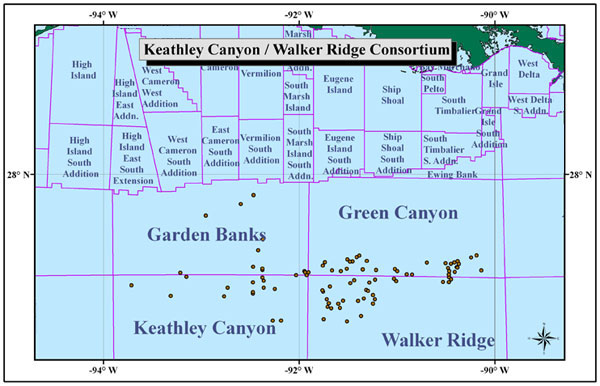
Lower Garden Banks/East Breaks
The Lower Garden Banks / East Breaks Study (1988) consists of 216 cores. Regional differences in seep density reinforce the association between hydrocarbon seeps and the thermal regime for the Jurassic petroleum system.
Deliverables for this study include PDF images of core logs (core locations and descriptions) and data volumes with the results of the following analyses: total scanning fluorescence, C15+ gas chromatography, and C1-C4 hydrocarbons (headspace).
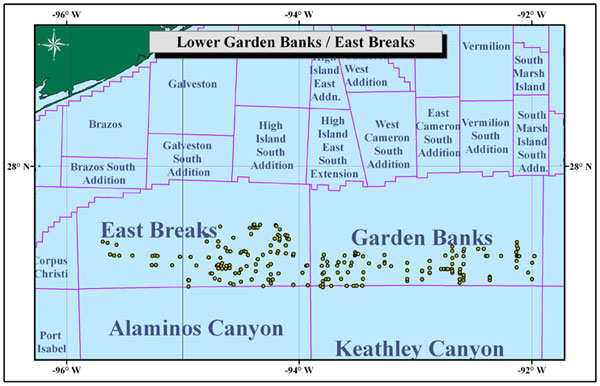
Mississippi Fan Fold Belt Study
The earliest piston coring surveys conducted in the deep-water Gulf of Mexico did not always site cores based on geophysical evidence of hydrocarbon seeps. The Mississippi Fan Fold Belt Study collected 229 cores primarily in the northern Atwater Valley protraction area. A single core was collected in the center of selected blocks in a general grid pattern. As a result, few cores showed significant liquid hydrocarbon anomalies. Several hydrocarbon seeps have been subsequently discovered in this region, although the numbers of seeps are less than in other areas of the deep-water Gulf, presumably as a result of sediment slumping around the Mississippi Fan Channel.
Deliverables for this study include PDF images of core logs (core locations and descriptions) and data volumes with the results of the following analyses: total scanning fluorescence, C15+ gas chromatography, C1-C4 hydrocarbons (headspace), and biomarker.
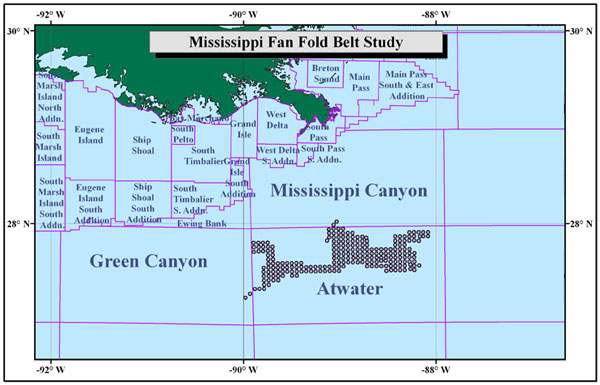
Upper Garden Banks/East Breaks
The Upper Garden Banks/East Breaks Study was one of the more important piston core surveys of the late 1980's, as it pre-dated the bulk of exploration drilling in this region. Results from 228 cores identify one of the most prolific seep belts along the Gulf of Mexico slope and clearly illustrate the relationship between seeps and major oil discoveries, such as Cooper and Auger. An equally compelling link is evident between areas lacking significant seepage and the incidence of dry holes.
Deliverables for this study include PDF images of core logs (core locations and descriptions) and data volumes with the results of the following analyses: total scanning fluorescence, C15+ gas chromatography, and C1-C4 hydrocarbons (headspace).
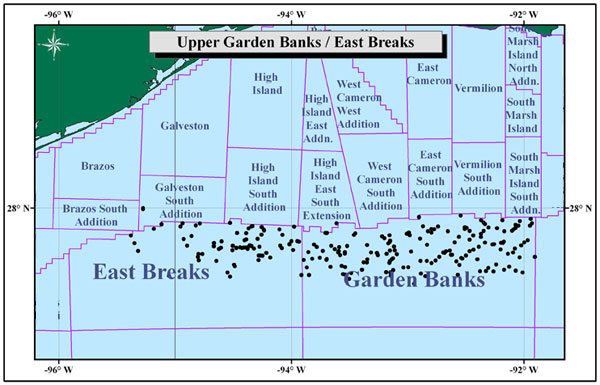
Western Gulf Consortium I
The Western Gulf Consortium (1996) encompassed 152 cores across Keathley Canyon, Walker Ridge, Alaminos Canyon, southern East Breaks and Garden Banks, sited using state-of-the-art geophysical techniques. The results delineate a major seep belt of presumably Upper Jurassic-sourced oil across part of the study area. The seepage intensity decreases to the west, an area in which the prolific Upper Jurassic source rocks are thermally overmature.
Deliverables for this study include PDF images of core logs (core locations and descriptions), data volumes with the results of the following analyses: total scanning fluorescence, C15+ gas chromatography, C1-C4 hydrocarbons (headspace), and biomarker, and a final, interpretive report.

Western Gulf Consortium II
The Western Gulf Consortium II (1997) in-filled the regional coverage of the 1996 Western Gulf Consortium with an additional 230 piston cores. In addition to identifying several new seep occurrences, biomarker analysis of the seeps addressed the question of carbonate source facies in this deep-water region.
Deliverables for this study include PDF images of core logs (core locations and descriptions), data volumes with the results of the following analyses: total scanning fluorescence, C15+ gas chromatography, C1-C4 hydrocarbons (headspace), isotope, and biomarker, and a final, interpretive report.
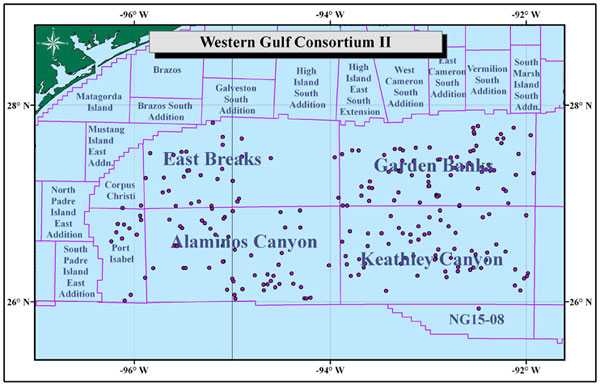
Western Gulf Consortium III
The Western Gulf III Study (1998) includes 125 cores whose locations were chosen using state of the art geophysics, and building upon previous studies. It was extremely successful because of project preparation and accurate targeting of core locations. The cores were concentrated in pivotal areas of interest in the western Gulf.
Deliverables for this study include PDF images of core logs (core locations and descriptions), data volumes with the results of the following analyses: total scanning fluorescence, C15+ gas chromatography, C1-C4 hydrocarbons (headspace), and biomarker, and a final, interpretive report.

